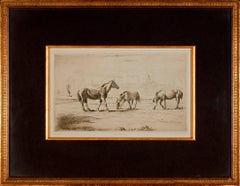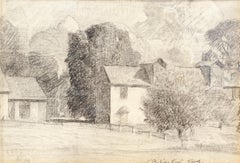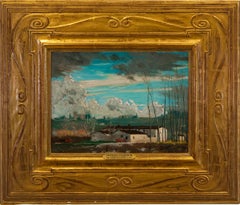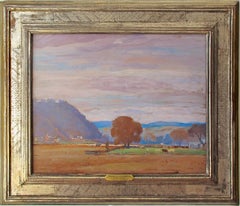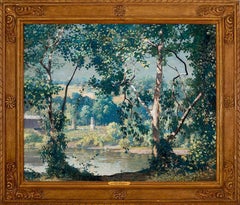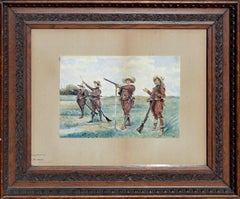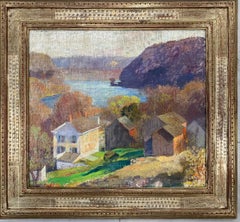Daniel Garber Art
to
15
14
13
2
8
3
2
1
1
Overall Height
to
Overall Width
to
15
5
2
2
2
2
2
1
1
1
1
1
1
1
1
1
1
1
15
2
2
2
4
15
6,886
3,210
2,514
1,217
5
5
3
3
3
Artist: Daniel Garber
"Old Barney"
By Daniel Garber
Located in Lambertville, NJ
Jim’s of Lambertville Fine Art Gallery is proud to present this piece by Daniel Garber (1880 - 1958).
One of the two most important and, so far, the most valuable of the New Hope Sc...
Category
Mid-20th Century American Impressionist Daniel Garber Art
Materials
Etching
Daniel Garber Original Drawing, from Artist's Estate
By Daniel Garber
Located in Larchmont, NY
Daniel Garber (American, 1880-1958)
Balderstons, c. Early 20th Century
Pencil on paper
7 x 9 in.
Framed: 12 x 4 x 1/2 in.
Titled and initialed lower right: Balderstons, D.G.
Proven...
Category
Early 20th Century American Impressionist Daniel Garber Art
Materials
Paper, Pencil
"Bellosguardo (Florence, Italy)"
By Daniel Garber
Located in Lambertville, NJ
Jim’s of Lambertville Fine Art Gallery is proud to present this piece by Daniel Garber (1880 - 1958).
One of the two most important and, so far, the most valuable of the New Hope Sc...
Category
Early 1900s American Impressionist Daniel Garber Art
Materials
Oil, Board
"Up the Valley"
By Daniel Garber
Located in Lambertville, NJ
In an original Harer frame.
Illustrated in "Daniel Garber Catalogue Raisonne" Vol. II, pg. 271, and in book titled "Blue Chips", pg. 33
Jim’s of Lambertville is proud to offer this artwork by:
Daniel Garber (1880-1958)
One of the two most important and, so far, the most valuable of the New Hope School Painters, Daniel Garber was born on April 11, 1880, in North Manchester, Indiana. At the age of seventeen, he studied at the Art Academy of Cincinnati with Vincent Nowottny. Moving to Philadelphia in 1899, he first attended classes at the "Darby School," near Fort Washington; a summer school run by Academy instructors Anshutz and Breckenridge. Later that year, he enrolled at the Pennsylvania Academy of the Fine Arts. His instructors at the Academy included Thomas Anshutz, William Merritt Chase and Cecilia Beaux. There Garber met fellow artist Mary Franklin while she was posing as a model for the portrait class of Hugh Breckenridge. After a two year courtship, Garber married Mary Franklin on June 21, 1901.
In May 1905, Garber was awarded the William Emlen Cresson Scholarship from the Pennsylvania Academy, which enabled him to spend two years for independent studies in England, Italy and France. He painted frequently while in Europe, creating a powerful body of colorful impressionist landscapes depicting various rural villages and farms scenes; exhibiting several of these works in the Paris Salon.
Upon his return, Garber began to teach Life and Antique Drawing classes at the Philadelphia School of Design for Women in 1907. In the summer of that same year, Garber and family settled in Lumbertville, Pennsylvania, a small town just north of New Hope. Their new home would come to be known as the "Cuttalossa," named after the creek which occupied part of the land. The family would divide the year, living six months in Philadelphia at the Green Street townhouse while he taught, and the rest of the time in Lambertville. Soon Garber’s career would take off as he began to receive a multitude of prestigious awards for his masterful Pennsylvania landscapes. During the fall of 1909, he was offered a position to teach at the Pennsylvania Academy as an assistant to Thomas Anshutz. Garber became an important instructor at the Academy, where he taught for forty-one years.
Daniel Garber painted masterful landscapes depicting the Pennsylvania and New Jersey countryside surrounding New Hope. Unlike his contemporary, Edward Redfield, Garber painted with a delicate technique using a thin application of paint. His paintings are filled with color and light projecting a feeling of endless depth. Although Like Redfield, Garber painted large exhibition size canvases with the intent of winning medals, and was extremely successful doing so, he was also very adept at painting small gem like paintings. He was also a fine draftsman creating a relatively large body of works on paper, mostly in charcoal, and a rare few works in pastel. Another of Garber’s many talents was etching. He created a series of approximately fifty different scenes, most of which are run in editions of fifty or less etchings per plate.
Throughout his distinguished career, Daniel Garber was awarded some of the highest honors bestowed upon an American artist. Some of his accolades include the First Hallgarten Prize from the National Academy in 1909, the Bronze Medal at the International Exposition in Buenos Aires in 1910, the Walter Lippincott Prize from the Pennsylvania Academy and the Potter Gold Medal at the Art Institute of Chicago in 1911, the Second Clark Prize and the Silver Medal from the Corcoran Gallery of Art for “Wilderness” in 1912, the Gold Medal from the Panama-Pacific Exposition in San Francisco of 1915, the Second Altman Prize in1915, the Shaw prize in 1916, the First Altman Prize in 1917, the Edward Stotesbury Prize in1918, the Temple Gold Medal, in 1919, the First William A...
Category
1940s American Impressionist Daniel Garber Art
Materials
Oil, Panel
"Fields in Jersey"
By Daniel Garber
Located in Lambertville, NJ
Jim’s of Lambertville Fine Art Gallery is proud to present this piece by Daniel Garber (1880 - 1958).
One of the two most important and, so far, the most valuable of the New Hope Sc...
Category
Early 1900s American Impressionist Daniel Garber Art
Materials
Oil, Canvas
"Horse Cart"
By Daniel Garber
Located in Lambertville, NJ
Jim’s of Lambertville Fine Art Gallery is proud to present this piece by Daniel Garber (1880 - 1958).
One of the two most important and, so far, the most valuable of the New Hope Sc...
Category
Early 20th Century American Impressionist Daniel Garber Art
Materials
Graphite, Paper
"View of Lambertville"
By Daniel Garber
Located in Lambertville, NJ
Jim’s of Lambertville Fine Art Gallery is proud to present this piece by Daniel Garber (1880 - 1958).
One of the two most important and, so far, the most valuable of the New Hope Sc...
Category
1940s American Impressionist Daniel Garber Art
Materials
Charcoal, Paper
"Bare Tree"
By Daniel Garber
Located in Lambertville, NJ
Jim’s of Lambertville Fine Art Gallery is proud to present this piece by Daniel Garber (1880 - 1958).
One of the two most important and, so far, the most valuable of the New Hope School Painters, Daniel Garber was born on April 11, 1880, in North Manchester, Indiana. At the age of seventeen, he studied at the Art Academy of Cincinnati with Vincent Nowottny. Moving to Philadelphia in 1899, he first attended classes at the "Darby School," near Fort Washington; a summer school run by Academy instructors Anshutz and Breckenridge. Later that year, he enrolled at the Pennsylvania Academy of the Fine Arts. His instructors at the Academy included Thomas Anshutz, William Merritt Chase and Cecilia Beaux. There Garber met fellow artist Mary Franklin while she was posing as a model for the portrait class of Hugh Breckenridge. After a two year courtship, Garber married Mary Franklin on June 21, 1901.
In May 1905, Garber was awarded the William Emlen Cresson Scholarship from the Pennsylvania Academy, which enabled him to spend two years for independent studies in England, Italy and France. He painted frequently while in Europe, creating a powerful body of colorful impressionist landscapes depicting various rural villages and farms scenes; exhibiting several of these works in the Paris Salon.
Upon his return, Garber began to teach Life and Antique Drawing classes at the Philadelphia School of Design for Women in 1907. In the summer of that same year, Garber and family settled in Lumbertville, Pennsylvania, a small town just north of New Hope. Their new home would come to be known as the "Cuttalossa," named after the creek which occupied part of the land. The family would divide the year, living six months in Philadelphia at the Green Street townhouse while he taught, and the rest of the time in Lambertville. Soon Garber’s career would take off as he began to receive a multitude of prestigious awards for his masterful Pennsylvania landscapes. During the fall of 1909, he was offered a position to teach at the Pennsylvania Academy as an assistant to Thomas Anshutz. Garber became an important instructor at the Academy, where he taught for forty-one years.
Daniel Garber painted masterful landscapes depicting the Pennsylvania and New Jersey countryside surrounding New Hope. Unlike his contemporary, Edward Redfield, Garber painted with a delicate technique using a thin application of paint. His paintings are filled with color and light projecting a feeling of endless depth. Although Like Redfield, Garber painted large exhibition size canvases with the intent of winning medals, and was extremely successful doing so, he was also very adept at painting small gem like paintings. He was also a fine draftsman creating a relatively large body of works on paper, mostly in charcoal, and a rare few works in pastel. Another of Garber’s many talents was etching. He created a series of approximately fifty different scenes, most of which are run in editions of fifty or less etchings per plate.
Throughout his distinguished career, Daniel Garber was awarded some of the highest honors bestowed upon an American artist. Some of his accolades include the First Hallgarten Prize from the National Academy in 1909, the Bronze Medal at the International Exposition in Buenos Aires in 1910, the Walter Lippincott Prize from the Pennsylvania Academy and the Potter Gold Medal at the Art Institute of Chicago in 1911, the Second Clark Prize and the Silver Medal from the Corcoran Gallery of Art for “Wilderness” in 1912, the Gold Medal from the Panama-Pacific Exposition in San Francisco of 1915, the Second Altman Prize in1915, the Shaw prize in 1916, the First Altman Prize in 1917, the Edward Stotesbury Prize in1918, the Temple Gold Medal, in 1919, the First William A...
Category
Early 20th Century American Impressionist Daniel Garber Art
Materials
Charcoal, Paper
"Lunch at the Stockton Inn"
By Daniel Garber
Located in Lambertville, NJ
Jim’s of Lambertville is proud to offer this artwork.
Signed lower left. Pencil drawing.
Complemented by a hand carved and gilt frame.
Daniel Garber (1880-1958)
...
Category
20th Century American Impressionist Daniel Garber Art
Materials
Paper, Pencil
"Spring Valley Willows"
By Daniel Garber
Located in Lambertville, NJ
Jim’s of Lambertville Fine Art Gallery is proud to present this piece by Daniel Garber (1880 - 1958).
One of the two most important and, so far, the most valuable of the New Hope School Painters, Daniel Garber was born on April 11, 1880, in North Manchester, Indiana. At the age of seventeen, he studied at the Art Academy of Cincinnati with Vincent Nowottny. Moving to Philadelphia in 1899, he first attended classes at the "Darby School," near Fort Washington; a summer school run by Academy instructors Anshutz and Breckenridge. Later that year, he enrolled at the Pennsylvania Academy of the Fine Arts. His instructors at the Academy included Thomas Anshutz, William Merritt Chase and Cecilia Beaux. There Garber met fellow artist Mary Franklin while she was posing as a model for the portrait class of Hugh Breckenridge. After a two year courtship, Garber married Mary Franklin on June 21, 1901.
In May 1905, Garber was awarded the William Emlen Cresson Scholarship from the Pennsylvania Academy, which enabled him to spend two years for independent studies in England, Italy and France. He painted frequently while in Europe, creating a powerful body of colorful impressionist landscapes depicting various rural villages and farms scenes; exhibiting several of these works in the Paris Salon.
Upon his return, Garber began to teach Life and Antique Drawing classes at the Philadelphia School of Design for Women in 1907. In the summer of that same year, Garber and family settled in Lumbertville, Pennsylvania, a small town just north of New Hope. Their new home would come to be known as the "Cuttalossa," named after the creek which occupied part of the land. The family would divide the year, living six months in Philadelphia at the Green Street townhouse while he taught, and the rest of the time in Lambertville. Soon Garber’s career would take off as he began to receive a multitude of prestigious awards for his masterful Pennsylvania landscapes. During the fall of 1909, he was offered a position to teach at the Pennsylvania Academy as an assistant to Thomas Anshutz. Garber became an important instructor at the Academy, where he taught for forty-one years.
Daniel Garber painted masterful landscapes depicting the Pennsylvania and New Jersey countryside surrounding New Hope. Unlike his contemporary, Edward Redfield, Garber painted with a delicate technique using a thin application of paint. His paintings are filled with color and light projecting a feeling of endless depth. Although Like Redfield, Garber painted large exhibition size canvases with the intent of winning medals, and was extremely successful doing so, he was also very adept at painting small gem like paintings. He was also a fine draftsman creating a relatively large body of works on paper, mostly in charcoal, and a rare few works in pastel. Another of Garber’s many talents was etching. He created a series of approximately fifty different scenes, most of which are run in editions of fifty or less etchings per plate.
Throughout his distinguished career, Daniel Garber was awarded some of the highest honors bestowed upon an American artist. Some of his accolades include the First Hallgarten Prize from the National Academy in 1909, the Bronze Medal at the International Exposition in Buenos Aires in 1910, the Walter Lippincott Prize from the Pennsylvania Academy and the Potter Gold Medal at the Art Institute of Chicago in 1911, the Second Clark Prize and the Silver Medal from the Corcoran Gallery of Art for “Wilderness” in 1912, the Gold Medal from the Panama-Pacific Exposition in San Francisco of 1915, the Second Altman Prize in1915, the Shaw prize in 1916, the First Altman Prize in 1917, the Edward Stotesbury Prize in1918, the Temple Gold Medal, in 1919, the First William A...
Category
1940s American Impressionist Daniel Garber Art
Materials
Etching
"Birmingham Meeting House"
By Daniel Garber
Located in Lambertville, NJ
Jim’s of Lambertville Fine Art Gallery is proud to present this piece by Daniel Garber (1880 - 1958).
One of the two most important and, so far, the most valuable of the New Hope Sc...
Category
1930s American Impressionist Daniel Garber Art
Materials
Etching
"Pigs"
By Daniel Garber
Located in Lambertville, NJ
Jim’s of Lambertville Fine Art Gallery is proud to present this piece by Daniel Garber (1880 - 1958).
One of the two most important and, so far, the most valuable of the New Hope Sc...
Category
1940s American Impressionist Daniel Garber Art
Materials
Charcoal
"Improvidence"
By Daniel Garber
Located in Lambertville, NJ
Jim’s of Lambertville Fine Art Gallery is proud to present this piece by Daniel Garber (1880 - 1958).
One of the two most important and, so far, the most valuable of the New Hope Sc...
Category
1920s American Impressionist Daniel Garber Art
Materials
Etching
"Frances in Braids"
By Daniel Garber
Located in Lambertville, NJ
Jim’s of Lambertville is proud to offer this artwork.
Pastel portrait of artist's granddaughter.
Complemented by original signed Harer frame.
Illustra...
Category
1930s American Impressionist Daniel Garber Art
Materials
Pastel
Harmonville
By Daniel Garber
Located in Missouri, MO
DANIEL GARBER
"Harmonville, Pennsylvania" c. 1925
Etching printed in black ink on wove paper.
7 7/8 x 11 3/4 inches, full margins.
Signed, titled and inscribed "DG imp" in pencil, ...
Category
1920s American Impressionist Daniel Garber Art
Materials
Etching
Related Items
Original Richard Burton, The Robe Film
By LeRoy Neiman
Located in Cumming, GA
Original Graphite Sketch on Paper
1953 / Signed 1959
Inscribed “Sketch for Robe Feature”
10 5/8″ x 13 1/2″ Viewable
25″ x 29 1/2″ Framed
The Robe, a fictional Biblical epic film was ...
Category
1950s American Impressionist Daniel Garber Art
Materials
Graphite
"Arquebusiers En Manoeuvre", After Marchetti
Located in Soquel, CA
Figurative landscape of four infantrymen in formation with their long arquebus guns by Adolphe Ancker (Dutch, 19th Century), after Marchetti. Signed and dated "Adolph Ancker 1888" lo...
Category
1880s American Impressionist Daniel Garber Art
Materials
Paper, Watercolor, Pencil
Brian Blood 'Monterey Bay' Plein Air California Impressionist Seascape Painting
By Brian Blood
Located in San Rafael, CA
Brian Blood (American, b. 1962)
Monterey Bay, 2000
Oil on canvas board
Signed lower right: BB signed, dated, and titled verso: Brian Blood, 2000 Monterey Bay
9in H x 12in L
In a silvered gilt frame with linen mat and moulding: 17 1/4in H x 20in L
Brian Blood is a resident of Pebble Beach, California. He began his professional life as a graphic artist and art director in Boston, Massachusetts. He then came to California to attend the Academy of Art College in San Francisco for both undergraduate and graduate studies. In 2003, Blood and his artist wife, Laurie Kersey...
Category
Early 2000s American Impressionist Daniel Garber Art
Materials
Oil, Canvas
H 17.5 in W 20 in D 2.5 in
"Sky Symphony" Oil Painting
By Leigh Ann Van Fossan
Located in Denver, CO
Leigh Ann Van Fossan's "Sky Symphony" is an original, handmade oil painting that depicts vivid pinks and purples coloring a sky as the sun sets on the day.
Category
2010s American Impressionist Daniel Garber Art
Materials
Oil, Panel
"Fire in the Sky" Oil Painting
By Leigh Ann Van Fossan
Located in Denver, CO
Leigh Ann Van Fossan's "Fire in the Sky" is an original, handmade oil painting that depicts a group of sailboats docked as a sunset colors the sky and water a vibrant orange hue.
Category
2010s American Impressionist Daniel Garber Art
Materials
Oil, Panel
"Train Station, " Max Kuehne, Industrial City Scene, American Impressionism
By Max Kuehne
Located in New York, NY
Max Kuehne (1880 - 1968)
Train Station, circa 1910
Watercolor on paper
8 1/4 x 10 1/4 inches
Signed lower right
Provenance:
Private Collection, Illinois
Max Kuehne was born in Halle, Germany on November 7, 1880. During his adolescence the family immigrated to America and settled in Flushing, New York. As a young man, Max was active in rowing events, bicycle racing, swimming and sailing. After experimenting with various occupations, Kuehne decided to study art, which led him to William Merritt Chase's famous school in New York; he was trained by Chase himself, then by Kenneth Hayes Miller. Chase was at the peak of his career, and his portraits were especially in demand. Kuehne would have profited from Chase's invaluable lessons in technique, as well as his inspirational personality. Miller, only four years older than Kuehne, was another of the many artists to benefit from Chase's teachings. Even though Miller still would have been under the spell of Chase upon Kuehne's arrival, he was already experimenting with an aestheticism that went beyond Chase's realism and virtuosity of the brush. Later Miller developed a style dependent upon volumetric figures that recall Italian Renaissance prototypes.
Kuehne moved from Miller to Robert Henri in 1909. Rockwell Kent, who also studied under Chase, Miller, and Henri, expressed what he felt were their respective contributions: "As Chase had taught us to use our eyes, and Henri to enlist our hearts, Miller called on us to use our heads." (Rockwell Kent, It's Me O Lord: The Autobiography of Rockwell Kent. New York: Dodd, Mead and Co., 1955, p. 83). Henri prompted Kuehne to search out the unvarnished realities of urban living; a notable portion of Henri's stylistic formula was incorporated into his work.
Having received such a thorough foundation in art, Kuehne spent a year in Europe's major art museums to study techniques of the old masters. His son Richard named Ernest Lawson as one of Max Kuehne's European traveling companions. In 1911 Kuehne moved to New York where he maintained a studio and painted everyday scenes around him, using the rather Manet-like, dark palette of Henri.
A trip to Gloucester during the following summer engendered a brighter palette. In the words of Gallatin (1924, p. 60), during that summer Kuehne "executed some of his most successful pictures, paintings full of sunlight . . . revealing the fact that he was becoming a colorist of considerable distinction." Kuehne was away in England the year of the Armory Show (1913), where he worked on powerful, painterly seascapes on the rocky shores of Cornwall. Possibly inspired by Henri - who had discovered Madrid in 1900 then took classes there in 1906, 1908 and 1912 - Kuehne visited Spain in 1914; in all, he would spend three years there, maintaining a studio in Granada. He developed his own impressionism and a greater simplicity while in Spain, under the influence of the brilliant Mediterranean light. George Bellows convinced Kuehne to spend the summer of 1919 in Rockport, Maine (near Camden). The influence of Bellows was more than casual; he would have intensified Kuehne's commitment to paint life "in the raw" around him.
After another brief trip to Spain in 1920, Kuehne went to the other Rockport (Cape Ann, Massachusetts) where he was accepted as a member of the vigorous art colony, spearheaded by Aldro T. Hibbard. Rockport's picturesque ambiance fulfilled the needs of an artist-sailor: as a writer in the Gloucester Daily Times explained, "Max Kuehne came to Rockport to paint, but he stayed to sail." The 1920s was a boom decade for Cape Ann, as it was for the rest of the nation. Kuehne's studio in Rockport was formerly occupied by Jonas Lie.
Kuehne spent the summer of 1923 in Paris, where in July, André Breton started a brawl as the curtain went up on a play by his rival Tristan Tzara; the event signified the demise of the Dada movement. Kuehne could not relate to this avant-garde art but was apparently influenced by more traditional painters — the Fauves, Nabis, and painters such as Bonnard. Gallatin perceived a looser handling and more brilliant color in the pictures Kuehne brought back to the States in the fall. In 1926, Kuehne won the First Honorable Mention at the Carnegie Institute, and he re-exhibited there, for example, in 1937 (Before the Wind). Besides painting, Kuehne did sculpture, decorative screens, and furniture work with carved and gilded molding. In addition, he designed and carved his own frames, and John Taylor Adams encouraged Kuehne to execute etchings. Through his talents in all these media he was able to survive the Depression, and during the 1940s and 1950s these activities almost eclipsed his easel painting. In later years, Kuehne's landscapes and still-lifes show the influence of Cézanne and Bonnard, and his style changed radically.
Max Kuehne died in 1968. He exhibited his work at the National Academy of Design, the Art Institute of Chicago, the Carnegie Institute in Pittsburgh, the Memorial Art Gallery of the University of Rochester, and in various New York City galleries. Kuehne's works are in the following public collections: the Detroit Institute of Arts (Marine Headland), the Whitney Museum (Diamond Hill...
Category
1910s American Impressionist Daniel Garber Art
Materials
Paper, Watercolor
Figure Bending Over
By John Singer Sargent
Located in New York, NY
Image dimensions: 5 ½ x 3 ½ inches
Framed dimensions: 12 ⅛ x 10 ⅜ inches
Inscribed at lower left: JS 220
Our drawing is also referred to as Young Boy Adjusting His Sandal, and is illustrated in the catalogue for Sargent's 1928 exhibition of drawings at Grand Central Art Galleries in New York. It is an example of an early study from life executed c. 1874-8.*
Sargent drew continuously from an early age and had benefited from the emphasis on drawing at the Accademia delle Belle Arti in Florence where he entered the life class in 1870. He arrived in Paris on May 16th, 1874, with a large portfolio of drawings...
Category
1870s American Impressionist Daniel Garber Art
Materials
Paper, Pencil
Garland Studies I
By John Singer Sargent
Located in New York, NY
Image dimensions: 7 ¼ x 10 ½ inches
Framed dimensions: 16 ½ x 20 inches
To produce his murals, Sargent painted monumental canvases in his studios in London and Boston, adhering them...
Category
1920s American Impressionist Daniel Garber Art
Materials
Paper, Pencil
Provence, France Fine Art Aquatint Etching - “Legendary Provence"
Located in Soquel, CA
Fine Art Aquatint Etching of Gordes, in Provence, France - "Legendary Provence" by Ronald Stephen Riddick
Beautiful aquatint etching of a sunset over iconic Provence French town, Go...
Category
1970s American Impressionist Daniel Garber Art
Materials
Paper, Aquatint
H 25 in W 38 in D 0.25 in
"Nocturne" Oil Painting
By Leigh Ann Van Fossan
Located in Denver, CO
Leigh Ann Van Fossan's "Nocturne" is an original, handmade oil painting that depicts sailboats floating in the darkness as their lights and the moon casts glimmering reflections on t...
Category
2010s American Impressionist Daniel Garber Art
Materials
Canvas, Oil
New Fish Market - NEW YORK
By Joseph Pennell
Located in Santa Monica, CA
JOSEPH PENNELL (1857 - 1926)
NEW FISH MARKET - (NEW YORK) 1921 (W 797)
Etching, Signed in pencil, edition probably 50. 9 7/8 x 6 7/8 inches. Full sheet, ...
Category
1920s American Impressionist Daniel Garber Art
Materials
Etching
Albert Lorey Groll, American 1866-1952 Pencil sketch.
By Albert Groll
Located in Hallowell, ME
6.5" x 8" pencil on paper. Crows in a landscape. In custom mat from Kennedy Galleries, approx 14" x 20"Born in New York City, Albert Lorey Groll became a much admired, successful western desert...
Category
Early 20th Century American Impressionist Daniel Garber Art
Materials
Pencil
Previously Available Items
Spring Valley, New Hope School, American Impressionist Landscape with Figures
By Daniel Garber
Located in Doylestown, PA
"Spring Valley" by Pennsylvania Impressionist and New Hope School painter Daniel Garber is an 19" x 25" charcoal on paper, regional landscape drawing with house and figures. It is in...
Category
Early 20th Century American Impressionist Daniel Garber Art
Materials
Charcoal, Archival Paper
H 29 in W 35 in D 1 in
"From Carey's Hill"
By Daniel Garber
Located in Lambertville, NJ
Jim’s of Lambertville is proud to offer this artwork by:
Daniel Garber (1880-1958)
One of the two most important and, so far, the most valuable of the New Hope School Painters, Da...
Category
1940s American Impressionist Daniel Garber Art
Materials
Canvas, Oil
"Sand Warf"
By Daniel Garber
Located in Lambertville, NJ
Jim’s of Lambertville is proud to offer this artwork.
Signed lower right.
Daniel Garber (1880-1958)
One of the two most important and, so far, the most valuable of the N...
Category
1920s American Impressionist Daniel Garber Art
Materials
Etching
"The Kimball Farm"
By Daniel Garber
Located in Lambertville, NJ
Signed lower center.
Complemented by a hand carved and gilt frame.
Exhibited at Art Alliance, 1918.
Illustrated in "Daniel Garber Catalog Raisonne", p. 115.
Daniel Garber (1880...
Category
1910s American Impressionist Daniel Garber Art
Materials
Oil, Board
"The Delaware"
By Daniel Garber
Located in Lambertville, NJ
Signed on the Verso.
Complemented by a hand carved and gilt frame.
Illustrated in "Daniel Garber Catalog Raisonne", p. 105.
Daniel Garber (1880-1958)
One of the two ...
Category
1910s American Impressionist Daniel Garber Art
Materials
Board, Oil
Carversville Church
By Daniel Garber
Located in Lambertville, NJ
Charcoal on laid paper
Featuring a signed Ben Badura frame.
One of the most important Pennsylvania Impressionist/ New Hope School painters. He was...
Category
20th Century Impressionist Daniel Garber Art
Materials
Charcoal
"The Sheep Pen at Cuttalossa"
By Daniel Garber
Located in Lambertville, NJ
Oil on tin Toleware tray.
Illustrated in "New Hope for American Art" and "Daniel Garber Catalog Raisonne", p.437
Daniel Garber (1880-1958)
One of the two mo...
Category
1930s American Impressionist Daniel Garber Art
Materials
Metal
River House
By Daniel Garber
Located in Lambertville, NJ
Edition of 50.
One of the most important Pennsylvania Impressionist/ New Hope School painters. One of Garber's many talents was etching, he created a series of approximately 50 diff...
Category
1930s Daniel Garber Art
Materials
Etching
Mary Franklin Garber Sewing
By Daniel Garber
Located in Lambertville, NJ
One of the most important Pennsylvania Impressionist/ New Hope School painters. He was a fine draftsman, creating a large body of work on paper, mostly in charcoal. Illustrated in "N...
Category
20th Century Daniel Garber Art
September Morning
By Daniel Garber
Located in Lambertville, NJ
farm animals landscape, signed lower right
Category
20th Century Daniel Garber Art
Materials
Oil, Board
Barn Ramp
By Daniel Garber
Located in Lambertville, NJ
*Original Stanford White design frame
Category
20th Century Impressionist Daniel Garber Art
Materials
Oil, Panel
Blue and Silver
By Daniel Garber
Located in Lambertville, NJ
Category
20th Century Daniel Garber Art
Materials
Oil, Board
Daniel Garber art for sale on 1stDibs.
Find a wide variety of authentic Daniel Garber art available for sale on 1stDibs. You can also browse by medium to find art by Daniel Garber in etching, paper, charcoal and more. Much of the original work by this artist or collective was created during the 20th century and is mostly associated with the Impressionist style. Not every interior allows for large Daniel Garber art, so small editions measuring 9 inches across are available. Customers who are interested in this artist might also find the work of Louis Oscar Griffith, Robert Hallowell, and Childe Hassam. Daniel Garber art prices can differ depending upon medium, time period and other attributes. On 1stDibs, the price for these items starts at $4,575 and tops out at $993,750, while the average work can sell for $28,125.
